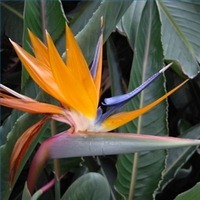Bird of paradise plants are native to South Africa but are now found in mild climates everywhere. This plant provides dramatic blooms that resemble a bird with a crown. It is also known as the crane flower.
-
Eye-catching orange plumes crown the plant.
The orange sepals of a bird of paradise form the most brilliant part of the plant. They provide the crowning glory on the "head" of the bird.
Blue Petals

The female part of the flower resides in the blue petals.
Rising from the "head" of the bird along with the orange sepals are the blue or purple petals. The female part of the plant is in these petals.
Bracts

The horizontal bracts supply the base from which the colorful flower emerges.
Bracts are leaves with modifications. In the bird of paradise, the bracts sit on top of a stalk. It is out of the horizontal bracts that the bright orange and blue flowers are displayed.
Leaves

Bird of paradise leaves resemble banana plant leaves.
The true leaves on the bird of paradise so closely resemble those of a banana plant that the bird of paradise was once classified in the same family. It now has its own classification: Strelitzia reginae.
Rhizomes
- Propagation by dividing rhizomes is the fastest way to grow new bird of paradise plants. The new plants will bloom in a couple of years.
Seeds
- Another method of propagation is done by planting the bird of paradise seeds. Expect new flowers to take longer with this method than with dividing rhizomes.


Deprecated: strpos(): Passing null to parameter #1 ($haystack) of type string is deprecated in /home/agriviek8Qv/agriviet.net/public_html/wp-includes/comment-template.php on line 2522